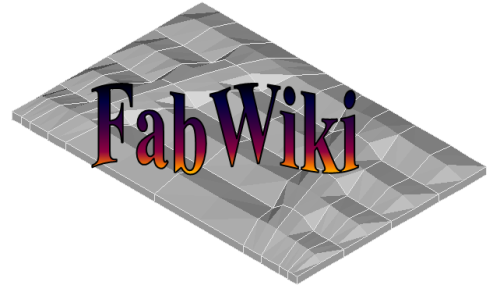This is an old revision of the document!
Table of Contents
Welcome to FabWiki
This WIKI provides “STATE-OF-THE-ART” information on fabric-formed concrete and it is hoped this site will contribute to the knowledge base and advancement of fabric formwork for architectural structures. If you have an interest in fabric-formed concrete and would like to contribute to this wiki please consider registering (click Login / register at top of page) If you have any questions, trouble registering or logging in please contact the webmaster: webmaster@fabwiki.fabric-formedconcrete.com
Introduction
This article focuses on fabric formworks for use in forming concrete members used in architectural works but it should be kept in mind that this versatile means of containing concrete saw some of its first use in civil engineering works such as those found in erosion control e.g., revetments and pond liners. Concrete members for architectural works have traditionally been cast using a rigid formwork in some desired arrangement ever since men first sought to contain early forms of mortar and “concrete” in their structures. And given the need for a mortar or concrete to set and cure properly the use of a flexible formwork might appear to be rather ill-suited for casting any concrete member. But, this method of casting concrete may in fact be used nearly anywhere a rigid formwork is used and is beginning to attract attention as a method of forming concrete members now that strong and inexpensive geotextiles have become available. This article will hopefully pique the reader's interest and leave you inspired to think beyond the simple prismatic shape through the use of fabric as a formwork for the construction of concrete members.
History and Background
Historically both civil engineering and architectural projects have benefited by the use of fabric as a formwork for concrete containment. We will take a look at those engineers, architects, designers and researchers who have made use of this unique way of forming concrete.
Developed and patented by Construction Techiques, Inc. in the mid-1960's Fabriform® is the original fabric-formed concrete system. Their products include Articulated Block, Filterpoint, Unimat, Concrete Bags and Pile Jackets. Engineers who have reported on the use of fabric-formed concrete lining used for slope protection include M. Phildysh and K. Wilson [1] and B.A. Lamberton [2].
One of the first architects to use a flexible formwork in an architectural application was the late Spanish architect Miguel Fisac with his 1970’s design of the Juan Zurita residence in Madrid, Spain. Another architect whose work has softened up concrete is Japanese architect Kenzo Unno. Working independently of Fisac he has developed several cast-in-place (CIP) fabric-formed wall systems since the mid 1990’s. Sandy Lawton, a Vermont Design/Builder has also used geotextiles to form the essential components of a structure including the columns, walls and floors.
Foundations, continuous and spread footings and piers (or columns), have also benefitted by the use of flexible fabric systems. Since 1993 Richard Fearn, owner and founder of Fab-Form Industries, Ltd., has developed and marketed several fabric forming products including; Fastfoot® for continuous and spread footings; Fastbag® for spread footings and Fast TubeTM for piers and columns.
Countries with schools of architecture and engineering with students conducting research include the United States, Canada, England, Scotland, Mexico, Chile, Belgium and the Netherlands. Some of the most prolific research currently being conducted is under the direction of Professor Mark West, Director of the Centre for Architectural Structures and Technology (C.A.S.T.) at the University of Manitoba, Canada. Professor West, an artist, educator and builder has invented a series of techniques for constructing fabric-formed walls, beams, columns, slabs and panels. In the following pages we will examine those structural forms, their applications and the engineering behind them in more detail and we invite you to contribute to “the knowledge base”.
References
[1] Pildysh, M. and Wilson, K., (September 1983), “Cooling ponds lined with fabric-formed concrete”, Concrete International, September 1983, pp 32-35.
[2] Lamberton, B.A., (December 1989), “Fabric Forms for Concrete”, Concrete International, December 1989, pp 58-67.
External Links
Fabriform
Fab-Form Industries, Ltd.
The Centre for Architectural Structures and Technology (C.A.S.T.)
Guidelines
Etiquette
Using this or any wiki requires we follow online etiquette. Following are a brief set of rules put in place so an enjoyable experience may be had by all:
- Respect what others have written.
- You may edit, add to or begin something new depending on your permissions level, set by the administrator.
- See Editorial Guide below.
- Use correct spelling and good grammar - the world will see what you write.
- It goes without saying that appropriate language must be used.
- Information presented must be factual.
- Cite your sources in the “references” section provided on each page - don't plagiarize.
These but a few brief guidelines. For those interested Wikipedia provides an extensive guideline list well worth reviewing.
Editorial Guide
For this wiki I would like to see new content follow the structure established in the initial articles written and comments confined to the “discussion page” on the tab following the article. We may have new articles added that present and discuss a new application for example and it is a “live” document undergoing constant change with many contributors. Words, sentences and paragraphs may be struck out and rewritten. That is fine, but eventually those articles will be “cleaned up” and rewritten into a formal document. As this wiki ages these guidelines may be revisited. See the Editorial Tools page for additional information.
Suggestion Box
Have a suggestion on how we might improve this wiki or the content we might add to it? Please add it to the Suggestion Box.

